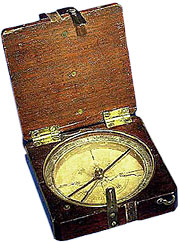School Days
 |
| Meriwether Lewis brushed up on all the navigational tools he could in preparation for the expedition. Here is the compass thought to be from the expedition. Image courtesy of National Museum of American History, Smithsonian Institution. |
The trip to Philadelphia would be Meriwether Lewis' college education. Instead of completing his degree in four years, though, Lewis had about a month.
With that short of a time frame, Philadelphia was the logical place to go. It was the cultural and intellectual center of the country.
Lewis received instruction from the country's finest minds:
Andrew Ellicott. He taught Lewis how to use the navigation instruments necessary for determining latitude and longitude.
Robert Patterson. A leading scientist who built on the navigation lessons Ellicott provided.
Thomas Parker. He provided Lewis with a chronometer.
Dr. Benjamin Rush. He advised Lewis on medical matters and supplied Lewis with purging pills, known as "Rush's pill," sometimes referred to as "Thunderclappers." Lewis already had a pretty good foundation in frontier medicine. Rush also provided Lewis with questions concerning the physical history, medicine, morals, and religion of the Indians.
Dr. Benjamin Smith Barton. A professor of botany at the University of Pennsylvania, Barton showed Lewis how to preserve flora and fauna specimens.
Dr. Caspar Wistar. America's leading fossil expert, Wistar spoke with Lewis about mammoths. He and Jefferson hoped evidence of them might be found in the West. He also wanted Lewis to look for evidence of the Megalonyx, discovered by Wistar and Jefferson.
By the second week of June 1803, Lewis was ready to put his education to use. He returned to Washington for his final instructions before setting off on a historic journey.
< previous | next > | 


